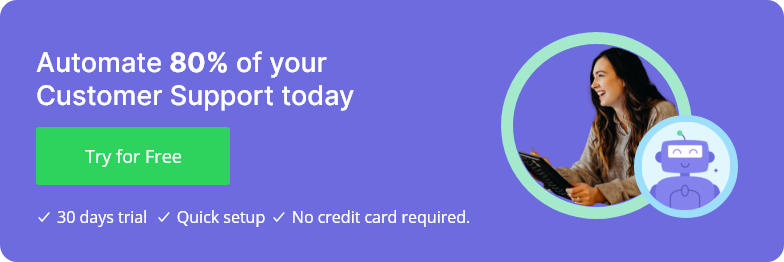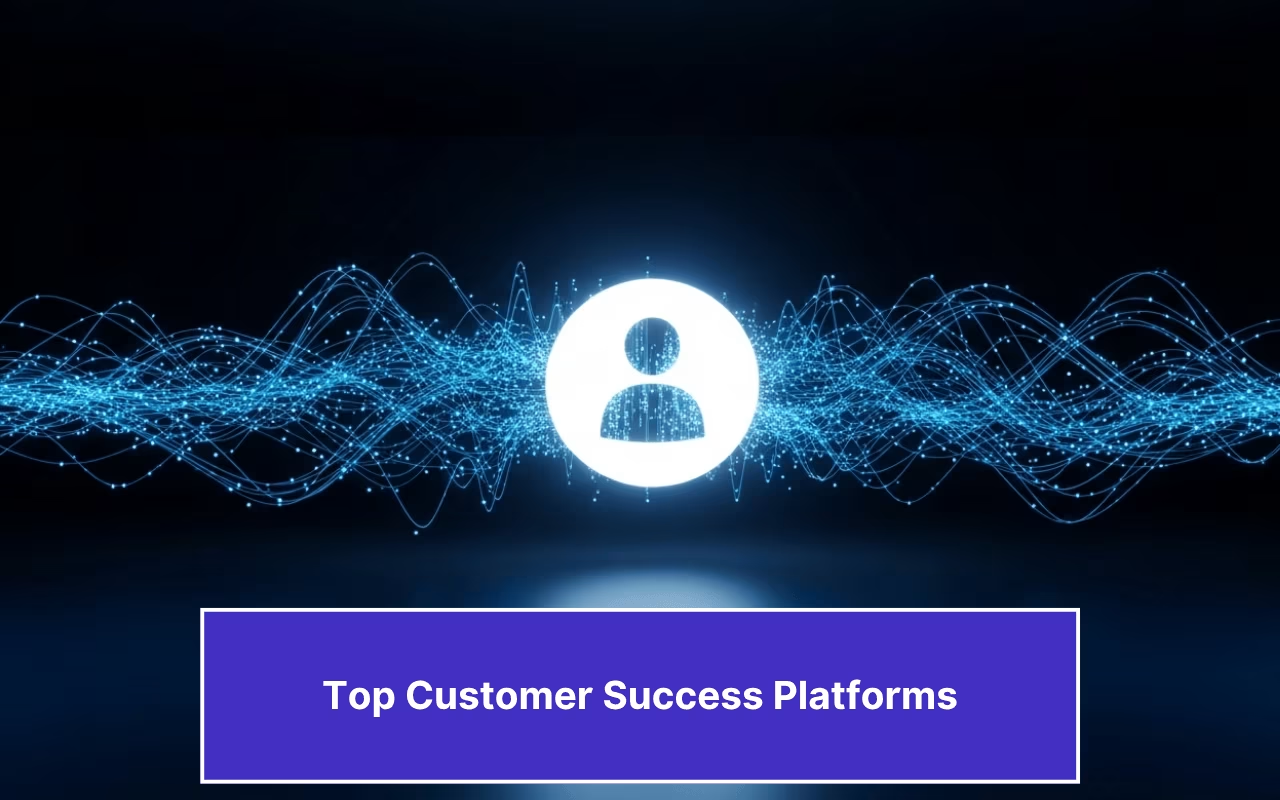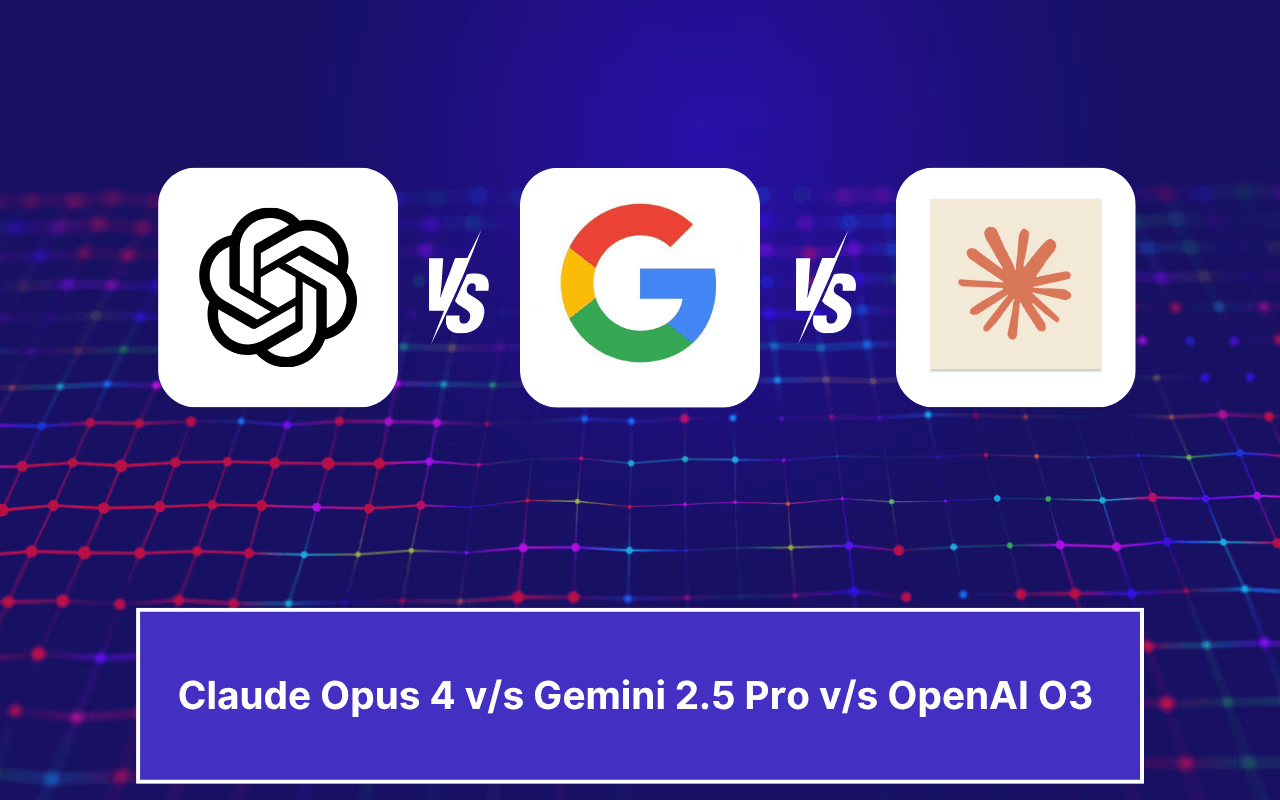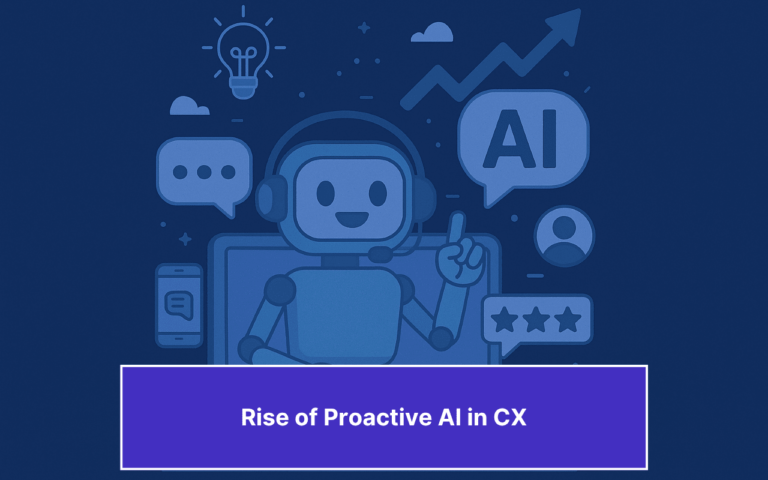Updated on May 15, 2025

Till now, if you called a business to connect with their customer service, the standard response was, “Press 1 for…” And after you spent three minutes trying to press the right buttons to get to a human agent, you would be on hold. You can connect with a human agent in 15 minutes or less if you’re lucky.
This long-winded process worsens your customers’ overall experience. It has exacerbated it so much that 42% of customers would rather clean a toilet than contact customer service.
The truth is that traditional IVR (Intelligent Voice Response) systems fail customers. Customers expect more natural, human-like conversations and get frustrated with endless menu options.
This can be solved by adding smart IVR deflections and voice AI to your customer service process. This article will look at these deflection and AI-based processes and cover:
- What is IVR Deflection?
- Why is the Current IVR Process a CX Bottleneck?
- How Can You Use Voice AI as IVR?
- How Can You Improve Your CX with Voice AI and Smart IVR Deflection?
- What are the Benefits of Voice AI & IVR Deflection?
- How Do Different Industries Use IVR Deflection?
- 5 Tips for Adding Smart IVR Deflection for Better CX
What is IVR Deflection?
Over the past two decades, IVR, or Intelligent Voice Response systems, have become synonymous with call centers. The idea behind IVR is simple. Instead of agents handling all calls directly, some basic processes are hidden behind a keyboard and voice-operated menu.
However, since you pre-program these responses, IVR systems have
- No contextual awareness
- No personalization
- No memory
Customers get the same three or four options whenever they call and reach your IVR. Additionally, IVR systems were developed in the 1960s, so they struggle with accurate speech recognition and can often trap your customers in a conversation loop.
One of the ways to mitigate all of this is IVR deflection. During deflection, a customer can be directed to another channel (usually live chat) where their questions can be answered.
Additionally, enterprises are increasingly adding AI to deflect AI-powered chatbots and email responders that can resolve L1 and L2 queries.
So, with proper IVR deflection, customers can skip the long wait times at the contact center and receive a resolution. This reduces call volumes and boosts the business’s first contact resolution rate (FCR).
Before we discuss the deflection process in detail, let’s understand why traditional IVR is a CX bottleneck and how it is primed for AI-led disruption.

Why is the Current IVR Process a CX Bottleneck?
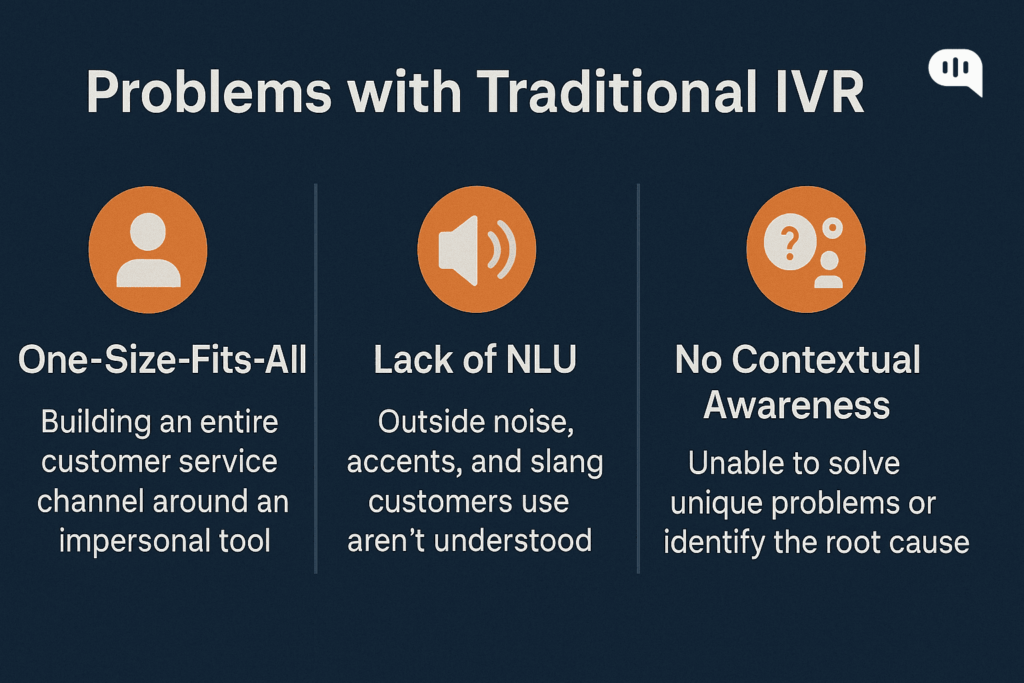
There are some inherent problems with the current IVR landscape that don’t match up with current customer expectations –
1. One-Size-Fits-All – We’ve written about how 63% of customers stop using brands that use poor personalization strategies. So, building an entire customer service channel around an impersonal, one-size-fits-all tool like traditional IVR is a poor business decision.
2. Lack of NLU – A lot of IVR technology is built on outdated technology. This causes a problem where outside noise, accents, and slang customers use aren’t understood. In a world where enterprises serve global customers, this lack of natural language understanding (NLU) is a clear disadvantage in CX terms.
3. No Contextual Awareness – A few days ago, Open AI released a feature that gave ChatGPT infinite memory. Currently, the LLM can provide personalized solutions to anyone using it. IVR systems with no memory awareness can’t solve the unique problems that a customer faces or identify the root cause of their issues.
These three problems mean that interactions between your IVR system and customers are extremely limited in scope and helpfulness. And that translates into an overall poor customer experience for all your customers.
Add in the fact that the phone remains one of the most popular and important channels for customer support, and you can understand why this poor customer experience is a problem across the board.
When we look at this CX bottleneck and the recent innovations around AI, we can understand why these traditional IVR systems are being replaced en masse. Businesses are using a combination of voice AI agents for customer service with smart IVR deflection to automate customer service workflows. Let’s take a look at this modern strategy in the next section.
How Can You Use Voice AI as IVR?
Put simply, a voice AI agent is an agent that acts on its own and becomes a full-scale contact center. These systems are powered by the latest iterations of large language models (LLMs). They are optimized to recognize customer complaints, provide solutions (while speaking like a human), and resolve L1 and L2 queries using your website and documentation.
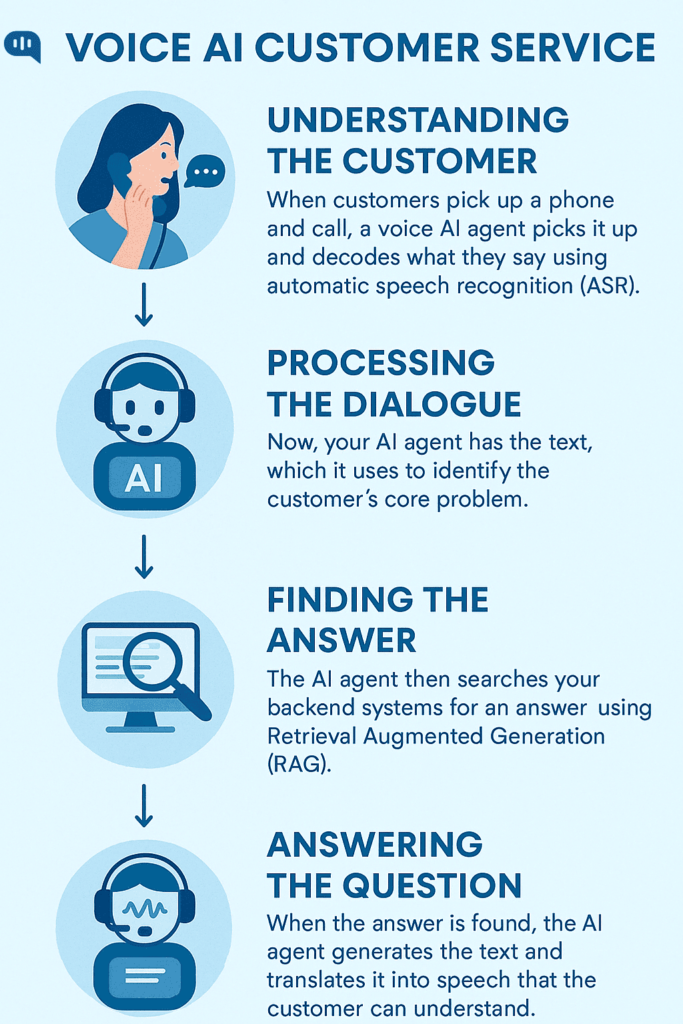
Voice AI customer service usually works like this:
1. Understanding the Customer – When customers pick up a phone and call, a voice AI agent picks it up and decodes what they say using automatic speech recognition (ASR). During this process, your customers’ words are turned into text.
2. Processing the Dialogue – Now, your AI agent has the text, which it uses to identify the customer’s core problem.
3. Finding the Answer – The AI agent then searches your backend systems for an answer using Retrieval Augmented Generation (RAG).
4. Answering the Question – When the answer is found, the AI agent generates the text and translates it into speech that the customer can understand.
And while this process looks long at the outset, much of the work is fast. Modern voice AI customer service systems (like the one at Kommunicate) can execute this entire process in seconds and have a human-like conversation with your customers.
Now, you have two options to add voice AI to your IVR process.
How to Integrate Voice AI into IVR?
There are three ways to use voice AI in your IVR processes –
1. Conversational IVR – If you replace the standard IVR process with voice AI. ASI components work together to converse with your customers and solve their basic and repetitive questions.
2. AI for IVR Enhancement – Some contact centers integrate IVRs tightly within their infrastructure. You can add AI’s speech recognition and language understanding properties to the IVR process in these cases.
3. Real-Time Processing – One of the biggest challenges in IVR is the latency, i.e., how long the system takes to answer a question. Using modern AI processes in these systems can improve latency and customer experience.
These approaches can help make your IVR system more powerful and efficient. Another layer of efficiency is added when you start adding smart IVR deflection to the process.
How Can You Improve Your CX with Voice AI and Smart IVR Deflection?
The call is usually routed to a human agent in traditional IVR flows. However, even with some call deflection handled by IVR, there’s a lot of wait time associated with this call routing process.
The trick, then, is to combine voice AI with clever deflection techniques. This deflection techniques let you –
1. Connect with your customers through other channels, including live chat and email.
2. Provide them with an appointed time during which a callback could be arranged.
These deflections ensure the customers solve their problems without waiting hours for a human agent.
You can set your IVR deflection using the following metrics.
Mechanisms to Set IVR Deflection
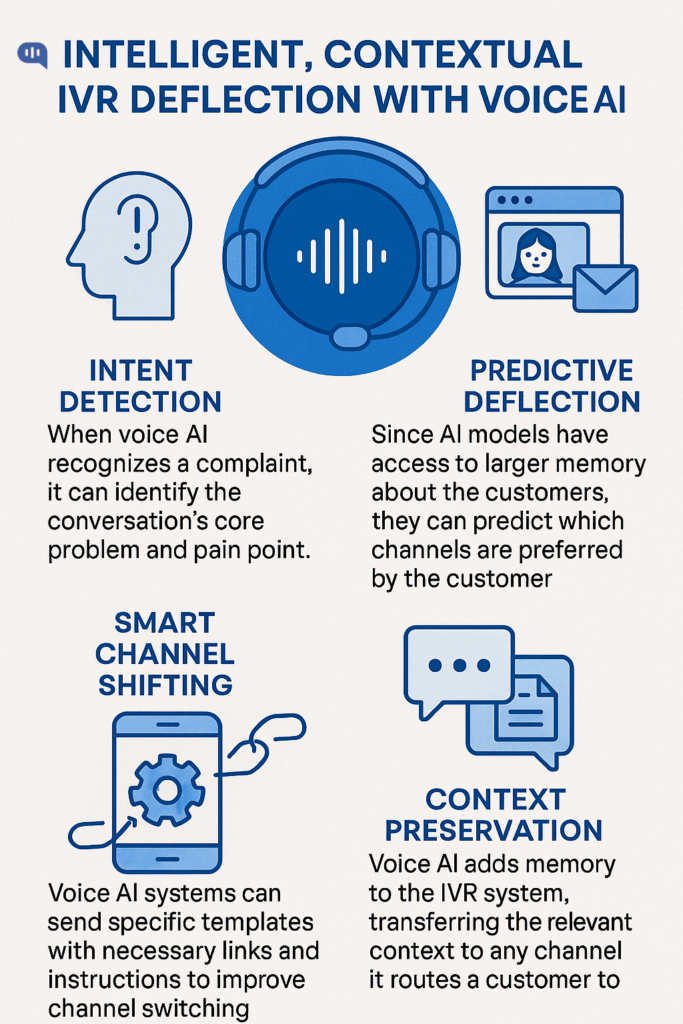
With voice AI, IVR deflection can be more intelligent and contextual. The methods you can use are:
1. Intent Detection – When voice AI recognizes a complaint, it can identify the conversation’s core problem and pain point. This lets the system identify the channels most suited to the customer’s problem. For example, for a significant technical challenge, the deflection can arrange a call back with an engineer.
2. Predictive Deflection – Since AI models have access to larger memory about the customers, they can predict which channels are preferred by the customer. If a customer likes solving problems through email, it will direct the complaint to the email channel.
3. Smart Channel Shifting – Seamlessly transitioning between channels in the traditional IVR context was difficult. However, voice AI systems can send specific templates with necessary links and instructions to improve channel switching.
4. Context Preservation – Another problem with traditional IVR systems was the lack of memory. Voice AI adds memory to the IVR system, and the model can transfer the relevant context to any channel it routes a customer to.
IVR deflections under the traditional route could often be frustrating for customers. They’d have to explain their problems to another agent in another channel and possibly repeat the conversation more than once. Voice AI improves IVR deflection and is a good way to resolve customer problems.
Of course, this combination will bring many benefits to your business. Let’s explore these benefits in the next section.
What are the Benefits of Voice AI & IVR Deflection?
Your business gains a competitive advantage by adding voice AI to IVR workflows. Let’s examine the quantitative and qualitative benefits of these integrations.
Quantitative Benefits
- Reduced average handle time (AHT) – Since many L1 and L2 customer service conversations are fully automated, the average handling time for each call is significantly reduced. This improves your business’s CSAT and NPS scores.
- Improved first call resolution (FCR) – With clever deflection and voice AI, your human and AI agents get better context about the customer’s problem. While this does not guarantee that all problems will be solved through one call, it improves your first-call resolution rates (FCR).
- 24/7 support without increasing headcount – Proper routing and deflection increase the efficiency of the customer support that your business can provide at scale. And 24/7 support means that more customers receive resolutions, and you can manage the improvement without increasing human resources.
Qualitative Benefits
- Happier customers – The first and most concrete benefit is that more customers get proper resolutions for their problems. More resolutions create happier customers.
- Less stressed agents – Proper deflection methodology adds structure to the customer service function. Your agents are given more business-critical and complex problems to solve and don’t have to do repetitive tasks of solving basic L1 and L2 questions. This reduces their stress and helps them manage their tasks and time better.
- Higher NPS and CSAT – Improved agent productivity and happier customers directly lead to higher NPS and CSAT scores across your organization.
These benefits turn into competitive advantages for your business. But how do companies use these deflection strategies? We’ve compiled a small table summarizing the use cases across different industries and verticals.
How Do Different Industries Use IVR Deflection?
We’ve looked at case studies and interviews with business leaders across different industries to compile the use cases of voice AI and IVR deflection across them. These are:
| Industry | Common Use Cases | Example Deflection Scenario |
| Banking & Finance | Balance inquiries, transaction history, fund transfers, reporting/blocking lost/stolen cards, loan statements, check orders, bill payments/reminders, and initial fraud reporting. | A customer calls about initiating a balance transfer. The AI IVR understands and verifies their identity, explains the process, and offers an SMS link to the online application form, deflecting the call from an agent. |
| Healthcare | Appointment scheduling/confirmation/reminders, prescription refills, accessing test results securely, answering questions about hours/locations/services, basic health info/symptom triage. | A patient calls for a prescription refill. The Conversational IVR authenticates and confirms medication details, processes the request automatically, and sends confirmation via SMS or portal link, avoiding agent involvement. |
| Retail & E-commerce | Order status updates (WISMO), product/stock inquiries, initiating returns/refunds, handling payments, checking gift card balances, store hours/locations. | A customer asks, “Where’s my recent order?”. The AI IVR authenticates, retrieves tracking info, reads it out and offers an SMS/WhatsApp message with a direct tracking link. |
| Telecom & Utilities | Bill inquiries/payments, account balance checks, reporting/checking service outages, and managing service changes. | A caller asks about paying their bill. The Conversational IVR offers immediate payment via voice, an SMS link to the online portal, or transfer to a billing agent for complex issues. |
| Travel & Hospitality | Making/modifying/canceling reservations, flight status/gate/baggage info, requesting hotel services (wake-up calls, amenities info), and loyalty program inquiries. | A guest calls to change hotel reservation dates. The AI IVR understands and verifies booking, checks availability, confirms changes and offers an updated confirmation email with a link for further online management. |
| Other Sectors (Education, Government, HR) | Course schedules, exam results, administrative details (Education), Information on regulations, public services, application statuses (Government), scheduling interviews, answering policy questions, and onboarding info (HR). | (General Principle) Voice AI understands specific requests and interacts with backend systems to handle complex informational queries or complete transactions, deflecting to the most efficient channel (voice, SMS, app, web, chatbot). |
Now that you know the real-life use cases of these voice AI and IVR deflection tools, we can discuss how to add these tools to your customer service systems.

5 Tips for Adding Smart IVR Deflection for Better CX
The core component should be built around good CX design to implement voice AI and IVR deflection into your system. Here are some guidelines that you should follow:
- Avoid Customer Frustration: Deflections need to be helpful and not frustrating. Focus on creating a functional conversation design and add error handling so your customers don’t get stuck in conversation loops.
- Build Trust: Some customers have had bad experiences and might not trust your deflection systems outright. Do small pilots and showcase the competency of your AI systems to improve trust in the tech tool.
- Focus on Handling Accuracy & Understanding Nuances: Your voice AI tool should be robust enough to handle real-world complexities: diverse accents, dialects, background noise, varying speech patterns, and the ambiguity inherent in human language. Errors in these processes lead to increased misunderstandings and are frustrating for customers.
- Implement Graceful Error Handling & Escalation: When the AI fails to understand or cannot resolve the issue, the system must handle the error gracefully. This includes avoiding repetitive failure loops and providing clear, simple, and readily accessible options for the caller to escalate to a human agent if they choose or if the situation warrants it.
- Balance Automation and Empathy: Balancing your AI implementation with empathy is essential. A good chatbot-human handoff function is crucial.
While your actual implementation of IVR and voice AI workflows will depend highly on the specific vendor, your CX will depend on how you design the overall interactions. This will improve your CX and the ROI of these tech integrations.
Conclusion
Traditional IVR systems have long been a pain point in customer service, creating frustration rather than solutions. By implementing voice AI and innovative IVR deflection strategies, businesses can transform this bottleneck into an opportunity for exceptional customer experience. Integrating AI-powered voice systems allows for more natural conversations, personalized interactions, and efficient problem resolution without the typical wait times and menu mazes.
The benefits are clear: reduced handle times, improved first-call resolution rates, 24/7 support capabilities, and ultimately, happier customers and less stressed agents. Across industries from banking to healthcare to retail, these technologies are proving their worth by handling routine inquiries while intelligently routing complex issues to the appropriate channels.
As customer expectations evolve, businesses embracing these innovations will gain a significant competitive advantage. The future of customer service isn’t about choosing between automation and the human touch—it’s about creating a seamless blend that leverages both strengths. By designing your implementation with customer experience at its core, you can ensure that every interaction builds trust and satisfaction rather than frustration.
The days of dreading customer service calls can be relegated to the past. With voice AI and clever IVR deflection, the new standard can be an efficient, personalized service that solves problems—the kind of experience that turns customers into advocates for your brand.
If you want to implement this workflow in your business, talk to us!

CEO & Co-Founder of Kommunicate, with 15+ years of experience in building exceptional AI and chat-based products. Believes the future is human + bot working together and complementing each other.

